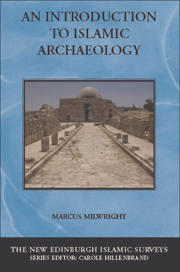Book contents
- Frontmatter
- Contents
- List of figures
- Acknowledgements
- Notes on transliteration and dating
- List of abbreviations
- 1 Introduction
- 2 Early Islam and late antiquity
- 3 New directions in the early Islamic period
- 4 The countryside
- 5 Towns, cities and palaces
- 6 Religious practice in the Islamic world
- 7 Crafts and industry
- 8 Travel and trade
- 9 The ‘post-medieval’ Islamic world
- 10 Conclusion
- Glossary
- Dynasties and periods
- Bibliography
- Index
8 - Travel and trade
Published online by Cambridge University Press: 05 August 2013
- Frontmatter
- Contents
- List of figures
- Acknowledgements
- Notes on transliteration and dating
- List of abbreviations
- 1 Introduction
- 2 Early Islam and late antiquity
- 3 New directions in the early Islamic period
- 4 The countryside
- 5 Towns, cities and palaces
- 6 Religious practice in the Islamic world
- 7 Crafts and industry
- 8 Travel and trade
- 9 The ‘post-medieval’ Islamic world
- 10 Conclusion
- Glossary
- Dynasties and periods
- Bibliography
- Index
Summary
The distribution of Indian and Chinese ceramics in the Persian Gulf and the occurrence of substantial hoards of dirhams in ‘European Russia’ and Scandinavia are significant indicators of increasing economic activity in the early Islamic centuries (chapter 3). The latter phenomenon should give grounds for caution, however, concerning the modes of exchange that led to this widespread dispersal of coins from mints in the eastern Islamic world. Certainly the demand for luxury goods among the wealthy occupants of Baghdad, Balkh, or Samarqand would have provided a powerful stimulus for Islamic merchants to travel to entrepôts on the Volga river and elsewhere to exchange silver coins for slaves, furs, wax, and honey, but the flow of currency northwards need not have occurred only by means of trade. Allowing for the existence of northern entrepôts such as Ladoga, it seems likely that the largely non-monetarised economies of dark age Russia, Scandinavia, and north-eastern Europe exchanged goods through other means: barter, theft, ‘protection money’ (such as the Danegeld paid to the Vikings by the English kings), gift-giving, and the redistribution of wealth by ruling elites. Nor should it be assumed that trade was the only mode of exchange in the more sophisticated economies of the pre-modern Islamic world; written sources record examples of expensive wedding dowries, of elaborate diplomatic gifts, and of the spreading of largesse by Muslim rulers during religious festivals, celebrations of the circumcision of their sons, and the investiture of state functionaries.
- Type
- Chapter
- Information
- An Introduction to Islamic Archaeology , pp. 159 - 173Publisher: Edinburgh University PressPrint publication year: 2010



